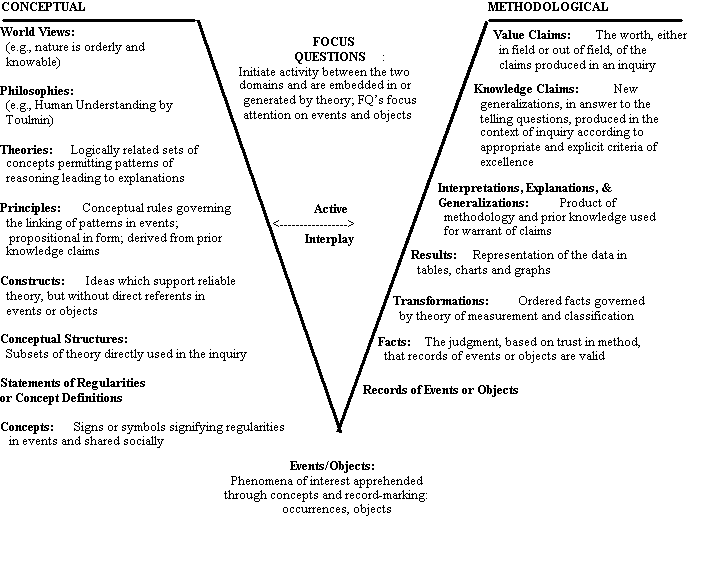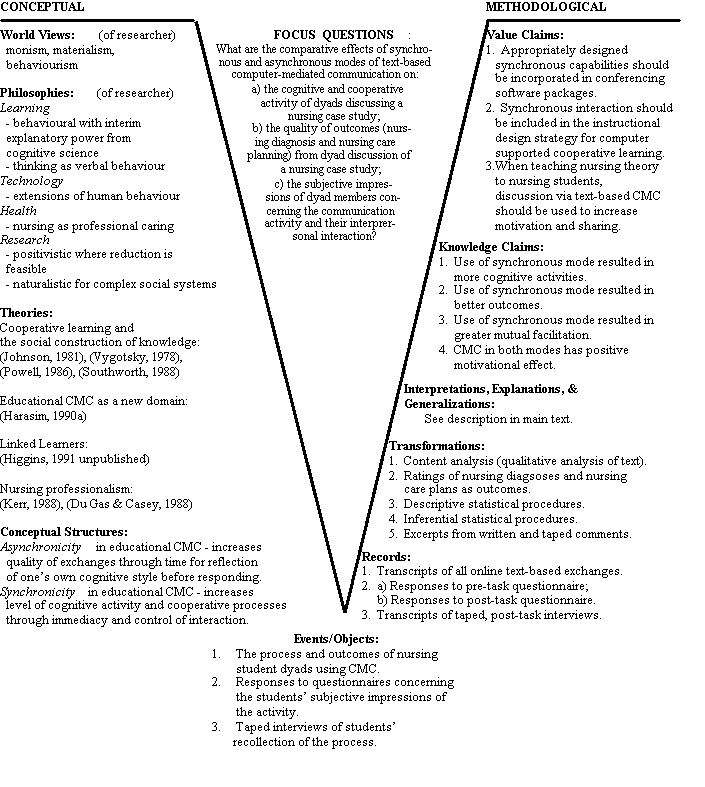
This figure was derived from Novak and Gowin (1984, p. 150)

Considering the great diversity of models and methods presently used in educational research, the specific orientation of this dissertation is elaborated in this section.
Novak and Gowin (1984) have noted that the conduct of research in education has been notoriously unproductive in contributing @CiteMark(NovakJD84a) knowledge claims that further human understanding. This is due, in part, to the artifactual nature of educational events and objects which are less consistent and predictable than naturally occurring events because of variations in human individuality (p. 149). It is also due to the fact that, in comparison to other disciplines, education has not adequately established its own set of theories and methodologies (p. 151).
Novak and Gowin propose theory-driven research based firmly in a theoretical and methodological framework of a discipline of education. They offer a heuristic model for the construction or analysis of knowledge in any discipline. This model, referred to as Gowin's Vee (p. 150), can be used to guide educational researchers in clarifying the theoretical and conceptual sources from which appropriate research questions arise and from which specific educational events or objects of study can be determined. Further, this heuristic can guide researchers in elaborating the necessary methodological devices required to prepare their observations as evidence to support the various claims and conclusions suggested by their findings. As such, the theoretical and conceptual basis, along with acceptable procedures for data generation, reduction, and presentation, provide the warrants required by the community of researchers for whom the resulting claims will have meaning.
Anderson (1987) discusses warrants at length. He notes, in particular, that warrants vary according to the ideological orientations of different scientific communities.
In strict rationalist (quantitative) research, the claim is an a priori hypothesis which is connected to (grounded by) some theoretical system, the evidence is presented in statistically analyzed quantified data, and the warrant is in the ideological system which contains the accepted practices of that community. In strict naturalist (qualitative) research, the claim is an a posteriori interpretative narrative grounded in membership, the evidence of which is held in field notes and the personal experience of the narrator, and the warrant is the ideological system which contains the accepted practices of that community @Cite(AndersonJA87a ", p. 77").
Of course, strict rationalist or naturalist positions are not as common as more flexible approaches which reflect elements of both paradigms. Nevertheless, claims must be warranted by links between the theories and concepts, the methodology, and the results of empirical investigation. The Gowin's Vee heuristic helps delineate and clarify the components of this research enterprise.
As shown in Figure @Ref(fgv1) the `V' shape of Gowin's Vee clearly separates the conceptual side, on the left, from the methodological side, on the right, while focussing the research questions downward through the vertex to the specific events or objects being studied. It is important to note that a distinction is made between the types of claims arising from research. Knowledge claims relate to the developing theory of the field, while value claims relate to the use of the new knowledge in practice. Both are supported by warrants that embody the ideological orientation and the accepted practice of the research communities they seek to inform.
Figure 2-1: Gowin's Vee

The current study is presented concisely via the Gowin's Vee heuristic in Figure @Ref(fgvhig1) and the remainder of this section provides a more elaborate outline of the pertinent components. The philosophies represent the general orientation of the researcher and are listed in order to help make some of the underlying assumptions explicit. The theories and principles show that a variety of established and developing theoretical positions were used to help situate this research. These theories provided the background needed to clarify important issues, to identify educational events for data generation, and to determine appropriate methods. The theories themselves were not being tested.
Figure 2-2: Gowin's Vee Representation of this Dissertation

Gowin's Vee Outline of this Dissertation
------------------------------- .....CONCEPTUAL..... ------------------------------- World Views and Philosophies: ============================= - general: - monism, materialism, behaviourism - social: - equality, sharing, cooperation - learning: - behavioural with interim explanatory power from cognitive science - thinking as verbal behaviour - technology: - extensions of human behaviour - health: - nursing as professional caring aimed at mutual resolution of health care deficits in individuals, groups, and communities - research: - positivistic where reduction is feasible with current models and tools - naturalistic methods when reduction is not feasible due to complex, open systems as in social science Theories: Principles and Constructs: ========= ========================== Cooperative learning and the social construction of knowledge: - teach thinking through discussion @Cite(JohnsonDW81a), - natural intelligence for mutual facilitation @Cite(VygotskyL78a), in the zone of proximal development (ZPD) @Cite(PowellJP86a), - communication for cooperation @Cite(SouthworthJH88a) - student-student constructionism vs. teacher-student instructionism - cooperation as an instructional strategy Educational CMC as a new domain: - computers mediate human communication @Cite(HarasimLM90a) - asynchronicity (independence of time) - independence of place - many to many interaction Linked learners: - interpersonal cognitive facilitation (Higgins, 1991 - CMC encompassing the full complement of unpublished) human behaviour and sensoria @CiteMark(HigginsRN91a) - computer supported cooperative learning - inter-dependent learning - education beyond the schools - life-long learning Nursing professionalism: - clarification, elaboration, and @Cite(KerrJR88a) standardization of theory and practice @Cite(DuGasBW89a) - move to B.Sc.N. for entry to practice - continuing education and upgrading Conceptual Structures: ====================== Asynchronicity in educational CMC: - increases quality of exchanges through time for reflection and integration of one's own cognitive style before responding Synchronicity in educational CMC: - increases level of cognitive activity and cooperative processes through immediacy and control of interaction Concepts: ========= positivist/rationalist natural intelligence naturalist independent learning human communication synchronous interaction cooperation asynchronous interaction computer-mediated communication (CMC) nursing diagnosis nursing care plan Focus Questions: ================ What are the comparative effects of synchronous and asynchronous modes of text-based computer-mediated communication on: a) the cognitive and cooperative activity of dyads discussing a nursing case study? b) the quality of outcomes (nursing diagnoses and nursing care planning) from dyad discussion of a nursing case stud) from dyad discussion of a nursing case study? c) the subjective impressions of dyad members concerning the communication activity and their interpersonal interaction? Events/Objects: =============== 1. The process and outcomes of nursing student dyads using CMC to discuss a case study with the aim of establishing nursing diagnoses and components of a nursing care plan. 2. Responses to questionnaires concerning the students' subjective impressions of the online communication and cooperative activity. 3. Taped interviews of students' recollection of the process of the online discussion and further subjective impressions. ---------------------------------------- .....METHODOLOGICAL..... ---------------------------------------- Records: ======== 1. Transcripts of all online text-based exchanges for both synchronous and asynchronous modes. 2. a) Responses to pre-task questionnaire covering age, education, and computer related experience. b) Responses to post-task questionnaire covering subjective impressions of the online communication activities. 3. Transcripts of taped, post-task interviews. Transformations: ================ 1. Content analysis (qualitative analysis of text) applied to the CMC transcripts in order to categorize, count, and sort items reflecting cognitive and cooperative activity. 2. Ratings of the form and correctness of nursing diagnoses and nursing care plans recorded in the CMC transcripts. 3. Descriptive statistical procedures applied to counts, ratings, and responses on the questionnaires and in the interviews. (frequencies, breakdowns, crosstabulations) 4. Inferential statistical procedures applied to counts, ratings, and responses on the questionnaires and in the interviews in order to enhance the descriptive power of the data while recognizing validity limitations related to sampling and coding. (t-tests, correlations) 5. Excerpts from written and taped comments organized and presented to demonstrate common or unique perceptions of the online experience. Interpretations, Explanations, & Generalizations: ================================================= - sample ... random assignment, self-selection 38 subjects: 1 dyad ftf, 9 dyads synch, 9 dyads asynch - sample homogeneous on education and computer experience - synch's produced larger numbers of verbal elements demonstrating attention to problem formulation, interactive arguing, facilitation, and management of the task - synch's were rated higher on nursing diagnoses, nursing care planning, and adherence to related guidelines and principles - t-tests applied to these dependent variables showed the differences to be significant (p < .05) (n = 9) - an increase in the index of key cognitive activity, problem formulation in particular, and adherence to guidelines and principles showed a positive correlation with total nursing diagnosis and nursing care planning scores (p < .05, Pearson) - no apparent or significant difference was found in the overall subjective impressions of either group. Both were very positive. Further, most comments (written and taped) from synch's and asynch's were very enthusiastic about this unique mode of group interaction. Knowledge Claims: ================= 1. Analysis of the transcripts suggests that task-oriented discussions in the synchronous mode of text-based computer-mediated communication are more likely to include verbal elements reflecting important cognitive activities such as problem formulation, interactive arguing, and task management than similar discussions in asynchronous mode. 2. Ratings of the nursing diagnoses, nursing care planning, and adherence to principles and guidelines (all as outcomes of the online discussions between dyad members) suggest that greater focus on, and accuracy of outcomes are possible with synchronous text-based CMC than with asynchronous. 3. Analysis of the transcripts suggests that greater mutual facilitation occurs in synchronous text-based CMC than in the asynchronous mode. This facilitation is reflected in verbal elements demonstrating attempts to establish interpersonal ease, support, understanding, and encouragement. 4. Written and taped comments and responses to the post-task questionnaire suggest that the novel and unique modes of interaction possible through computer-mediated communication (synchronous and asynchronous) can have a motivating effect for learning activities undertaken in dyad or group situations. Value Claims: ============= - when text-based CMC is used as an educational delivery system, appropriately designed synchronous capabilities should be incorporated in conferencing software packages - when text-based CMC is used to support student-student cooperative learning, synchronous interaction should be included in the instructional design strategy - when teaching nursing theory to nursing students, discussion via text-based CMC should be used to increase motivation and sharing




